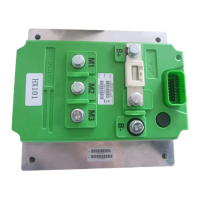Vehicle performance configuration
If your vehicle system does not include a VCU capable of providing raw motor control commands via H-
Protocol, then the vehicle application sub-systems within the controller can be utilised to provide these
signals for you.
Vehicle sub-systems such as TracApp and PumpApp can take in external signals using I-Protocol, and
generate the H-Protocol commands appropriate for driving the vehicle.
TracApp is capable of providing drive signals for a range of vehicle types, covering on-road and
industrial applications.
Requirements
In order to use TracApp, the following signals must be provided as a minimum:
• An analogue throttle signal
• Two digital signals, forward and reverse, used to select the drive direction
Depending on the application, other signals will be required in order to maintain safe operation. For
instance, an FS1 switch may be required by the application in order to validate the throttle position.
Vehicle application subsystems can be enabled by setting Object Dictionary index 5800h to enable
master functionality. Note, on a multi node system, it is only necessary to enable this on one node, as this
will be providing H-Protocol drive commands for all other nodes via CAN.
For information regarding how to map physical H-Protocol and I-Protocol inputs and outputs to vehicle
functions, refer to Sevcon Application Note “Mapping J1939 Signals to Vehicle Application Subsystems”.
Safety Interlocks
FS1
The FS1 switch is normally part of the throttle assembly. It closes when the throttle is pressed. The
throttle voltage is ignored until FS1 is closed.
FS1 features are configured at 2914
h
:
• SRO (static return to off): inhibits drive if FS1 is closed for the SRO delay without any direction
(forward or reverse) being selected.
• FS1 recycle: forces the operator to lift their foot off the throttle before allowing drive after a
direction change.
Deadman
The deadman switch operates similar to the FS1 switch, whereby, it inhibits drive until it is active.
However, the deadman switch applies the electro-mechanical brake immediately on deactivation,
whereas FS1 waits for the vehicle to stop before applying the brake.
Seat
The seat switch indicates operator presence on the vehicle. Drive is not allowed if this switch is open. If
the seat switch opens during drive for a period longer than the seat switch delay, a fault is set, disabling
drive. To clear a seat fault, close the seat switch, open FS1 and deselect the forward/reverse switch.
Set the seat switch delay at object 2902
h
.

